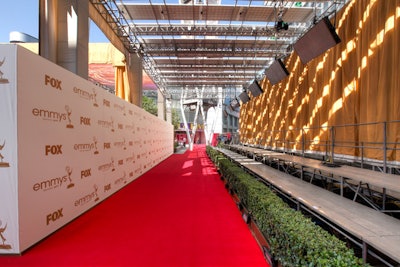
Getting bold-faced names and top-tier press to an event's arrivals carpet is an excellent start toward successful media coverage—but it's not everything. Consider these tips from pros on how to create a red carpet that's efficient, effective, and relatively chaos free.
1. Size matters
There's no one-size-fits-all approach for how long an arrivals carpet should be, but getting it right is key to achieving the appropriate kind of environment as well as a sense of order. "It's very tough for a red carpet to run smoothly if it's too packed—it becomes a bottleneck. On the other hand, if you overcompensate and have too big of a space, and it looks empty or feels empty, and that does not bode well for the hot factor," says YourBash's Jaime Geffen.
Cara Kleinhaut from Caravents adds, "Make sure the carpet is long enough to accommodate the number of expected news outlets."
And do your homework to make sure there are no surprises. "Always do a walk-through of the space in advance and know how much real estate you are working with. You never want to overbook a press line and have too many outlets or bodies there and not enough room," says PR Dept.'s Chet Mehta.
2. Assign spaces
You might think you'll risk turning off some press people if you limit them to preassigned areas on the carpet, but in fact it's the opposite, because the resulting setup is a much more organized and sane one. "Always mark spots," Mehta says. "It just keeps the check-in process and load in streamlined, and the photographers prefer it."
3. Staff up
Have enough staff on hand to make the arrivals process run smoothly, and know where to position them for maximum success. "Having a strong publicist act as a red carpet captain at the top of the carpet that can help control traffic flow is always key," says PR Dept.'s Mehta. "Best to also staff an event with talent handlers that can quickly get talent through—get the shot, get the interviews needed to get coverage, and get their tickets pulled and [get the guest] into the event."
Caravents' Kleinhaut adds, "Give publicists and managers a secure space at the end of the arrivals line to meet their client so they are not clustered on the carpet."
4. Name check
Prepare an accurate list of names to make the media's job as easy as possible—and secure the desired event press without delay or unnecessary risk of inaccuracy. "Writing out the names of red carpet arrivals rather than shouting them is more effective and saves media time Googling the spelling of their names—they are always very thankful," says Pivotal Public Relations president Jen Betts. For further ease, she adds, "Alphabetize your red carpet list by first name."
5. Mind the unglamorous details
The red carpet's an exciting and glamorous place, but it only works if a solid plan is in place to watch for all the unsexy details. "First and foremost, make a sound arrivals plan: security deployment, barricade placement, traffic redirection, pedestrian walkways, drop-off locations, press wall, carpet, risers, etc.," says Caravents' Kleinhaut. "Make sure you have all the proper permits and lane and sidewalk closures to set up in the location you plan to place your arrivals area. Know the permitting rules specific to each city you are working in."
6. Make a weather plan
Just as you'd plan weather contingencies for main event spaces, plan them for arrivals, as well. "If it's going to be cold or drizzling, tent and heat it to keep everyone on the carpet and in the arrivals area comfortable and happy," Kleinhaut says. "A cold celebrity will skip the carpet and go right inside—which can't happen."
7. Keep the carpet clear
If only the target guests make their way down the red carpet—without peripheral people cluttering up the line—the media will more easily get the shots and interviews they need, and the whole process will be much quicker and more streamlined. One way to keep the area clear and orderly, Kleinhaut says, is to "keep drop off for V.I.P.s walking the carpet and general event guests in two separate locations."
Pivotal's Betts adds, "Don't let plus-ones or entourages on the carpet unless it is preapproved. And don't let press agents escort unless preapproved."
8. Consider your end goal
Ultimately, consider the specific purpose for a given arrivals line early in the game. "A red carpet should reflect the PR strategy," PR Dept.'s Mehta says. "Is the goal a calm and controlled carpet that is stress free? Then just have a handful of top-tier photo agencies with the biggest and widest national and international reach."



















